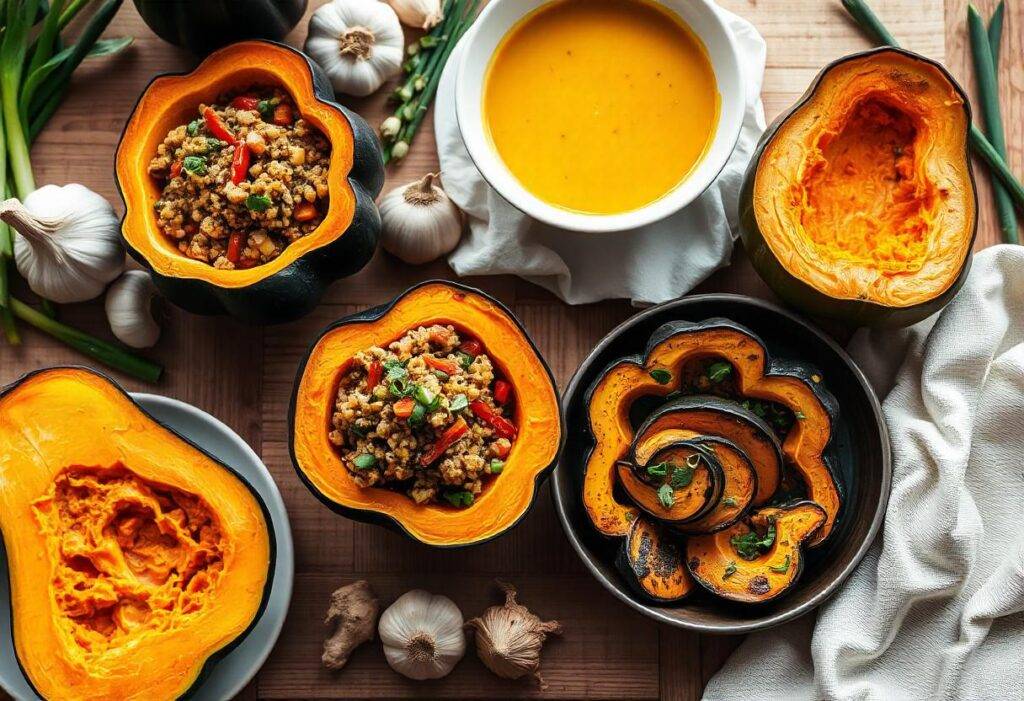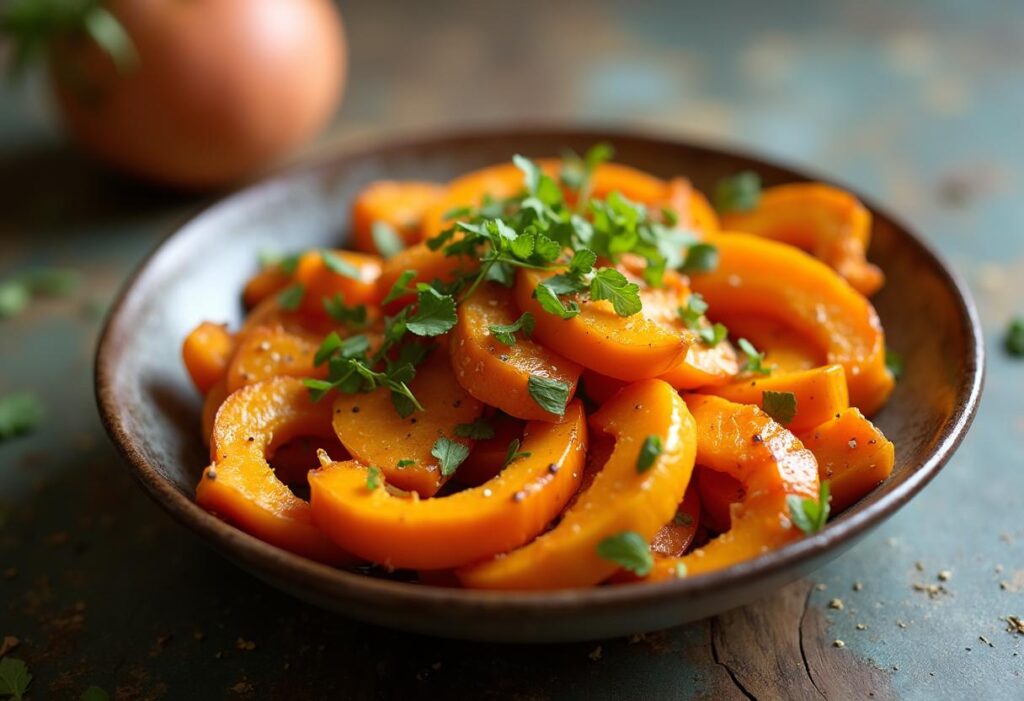
If you’re a fan of vegan cuisine and Chinese flavors, you’re in for a treat! This article will take you on a delicious journey through the world of Chinese squash recipes kabocha vegan. We’ll explore how the versatile kabocha squash can be transformed into mouthwatering vegan dishes, offering you not only a taste of Chinese-inspired cooking but also a healthy, plant-based way to enjoy this nutritious squash. Whether you’re looking for stir-fries, soups, or dumplings, there’s a recipe here for every occasion. So, let’s dive right in and discover the magic of kabocha squash in vegan Chinese dishes!
Table of contents
Introduction to Kabocha Squash in Vegan Chinese Cuisine
Overview of Kabocha Squash
When you first lay eyes on kabocha squash, you might think it’s just another pumpkin variety, but it’s so much more than that. This small, round squash is known for its deep green skin and vibrant orange flesh. Its sweet, creamy texture makes it an ideal ingredient for both savory and sweet dishes, and it’s packed with nutrients like fiber, vitamins, and antioxidants.
The rich, buttery flavor of kabocha squash is a perfect match for many vegan Chinese recipes, making it a staple in plant-based kitchens. It’s not just tasty—it’s also a powerhouse of nutrients that’ll keep you feeling full and satisfied.
Role of Kabocha Squash in Chinese Cooking
In traditional Chinese cooking, squash might not always take the center stage, but it plays an important supporting role in dishes, particularly in stews, stir-fries, and soups. As Chinese cuisine increasingly embraces plant-based cooking, kabocha squash has found its place in many vegan variations of these classic dishes.
Its naturally sweet flavor pairs beautifully with savory Chinese seasonings like soy sauce, ginger, garlic, and sesame oil. What’s more, it’s incredibly versatile—you can bake it, roast it, stir-fry it, or even use it in dumplings. The squash’s ability to soak up flavors and its smooth, velvety texture make it the perfect candidate for vegan Chinese squash recipes that you’ll want to make again and again.
Essential Ingredients and Preparation Techniques
Key Ingredients for Vegan Chinese Dishes
To make Chinese squash recipes kabocha vegan come to life, you’ll need a few essential ingredients that form the backbone of many vegan Chinese dishes. These ingredients are easy to find and help enhance the flavor profile of your squash-based meals. Here are some must-haves:
- Soy Sauce – This is a key component for adding that savory, umami flavor to your dishes. Whether you choose light or dark soy sauce, it will bring a depth of flavor that complements the natural sweetness of kabocha squash.
- Tofu – Tofu adds protein and texture, making it a perfect addition to any vegan dish. Firm tofu works best in stir-fries or soups.
- Rice Vinegar – For a tangy kick, rice vinegar is essential in balancing the sweetness of the squash and the richness of the sauces.
- Sesame Oil – This fragrant oil is a staple in Chinese cooking. A little goes a long way, giving your dishes a nutty, smoky aroma.
- Ginger and Garlic – These aromatic ingredients are crucial in building the base of many Chinese dishes, adding warmth and complexity.
In addition to these, you can experiment with other ingredients like hoisin sauce, chili paste, and fresh herbs to customize the flavor of your kabocha squash recipes.
Preparing Kabocha Squash for Cooking
Now that you have your ingredients ready, it’s time to prep the kabocha squash for your vegan Chinese creations. Although this squash might look intimidating at first, it’s surprisingly simple to work with. Here’s how to prepare it:
- Peel and Cut – Start by slicing off the top and bottom of the squash to create a stable base. Use a sharp knife to carefully peel the skin. Kabocha’s skin is a bit tough, but it’s totally worth it for the texture it gives to your dish. Once peeled, cut the squash in half and scoop out the seeds.
- Cube or Slice – Depending on your recipe, you can cube or slice the squash. For stir-fries, cubes work well, while thin slices are great for soups or stews. The key is to cut them evenly so they cook at the same rate.
- Cook – You can steam, roast, or stir-fry your kabocha squash, depending on the recipe you choose. Roasting will bring out its natural sweetness, while stir-frying will allow it to absorb all the delicious seasonings and flavors.
Once your squash is prepped, you’re all set to move on to the fun part—cooking! In the next section, we’ll dive into some tasty Chinese squash recipes kabocha vegan that’ll leave you craving more.
Vegan Chinese Kabocha Squash Recipes

Stir-Fried Kabocha Squash with Tofu
This stir-fry is a quick, flavorful way to enjoy kabocha squash with tofu. It’s the perfect balance of sweet, savory, and just a hint of spice. Here’s how to make it:
Ingredients:
- 2 cups of cubed kabocha squash
- 1 block firm tofu, drained and cubed
- 2 tablespoons soy sauce
- 1 tablespoon sesame oil
- 1 tablespoon rice vinegar
- 1 teaspoon ginger, grated
- 2 cloves garlic, minced
- 1/2 teaspoon chili flakes (optional)
- Fresh cilantro for garnish
Instructions:
- Heat sesame oil in a large pan over medium heat. Add the ginger and garlic and sauté for a minute until fragrant.
- Add the tofu cubes and stir-fry for 5-7 minutes until golden and crispy on the outside.
- Toss in the kabocha squash, soy sauce, and rice vinegar. Stir to coat evenly. Cook for another 7-10 minutes until the squash is tender but still holds its shape.
- Add chili flakes for an extra kick, and garnish with fresh cilantro before serving.
This Chinese squash recipe kabocha vegan is both nutritious and satisfying. It’s perfect on its own or served with steamed rice.
Kabocha Squash and Mushroom Hot Pot
For a cozy, hearty dish, look no further than this kabocha squash and mushroom hot pot. It’s warming, comforting, and a great option for a family meal. Here’s the recipe:
Ingredients:
- 2 cups kabocha squash, cubed
- 1 cup mushrooms, sliced
- 4 cups vegetable broth
- 1 tablespoon soy sauce
- 1 tablespoon rice vinegar
- 1 teaspoon sesame oil
- 1/2 teaspoon garlic powder
- Fresh scallions for garnish
Instructions:
- In a large pot, bring the vegetable broth to a boil.
- Add the kabocha squash, mushrooms, soy sauce, rice vinegar, and sesame oil. Lower the heat and simmer for about 20 minutes, or until the squash is tender.
- Season with garlic powder and adjust the flavors as needed. Add more soy sauce or vinegar to taste.
- Garnish with chopped scallions and serve hot with a side of rice.
This hot pot is a fantastic example of Chinese squash recipes kabocha vegan at its finest—simple, flavorful, and filling.
Sweet and Sour Kabocha Squash
Who doesn’t love a good sweet and sour dish? This kabocha squash recipe brings a plant-based twist to the classic, creating a delicious balance of flavors that’s perfect for any occasion.
Ingredients:
- 3 cups kabocha squash, cubed
- 1/4 cup rice vinegar
- 1/4 cup sugar
- 2 tablespoons soy sauce
- 1 tablespoon ketchup
- 1/4 cup water
- 1 tablespoon cornstarch mixed with 2 tablespoons water (for thickening)
Instructions:
- In a saucepan, combine rice vinegar, sugar, soy sauce, ketchup, and water. Bring to a simmer and stir until the sugar dissolves.
- Add the kabocha squash to the sauce and cook for 10-15 minutes, until the squash softens.
- Slowly add the cornstarch mixture and cook for another 3 minutes, or until the sauce thickens and becomes glossy.
- Serve hot, garnished with sesame seeds.
This sweet and sour kabocha squash recipe is a delightful fusion of savory and tangy flavors that’s sure to be a hit with everyone!
Kabocha Squash Dumplings
Dumplings are a beloved staple in Chinese cuisine, and these kabocha squash dumplings offer a vegan-friendly version that’s just as tasty as the traditional ones.
Ingredients:
- 1 cup kabocha squash, mashed
- 1/2 cup chopped mushrooms
- 1 tablespoon soy sauce
- 1 tablespoon sesame oil
- Dumpling wrappers
Instructions:
- In a pan, sauté the mushrooms in sesame oil until soft. Add the mashed kabocha squash and soy sauce. Cook for 5 minutes, then let the mixture cool.
- Place a spoonful of the mixture in the center of each dumpling wrapper, fold, and seal the edges.
- Steam the dumplings for 10-12 minutes, or until the wrappers become translucent.
- Serve with soy sauce for dipping.
These dumplings are a perfect bite-sized treat and a great way to enjoy Chinese squash recipes kabocha vegan in a fun and delicious form.
Cooking and Serving Tips for Vegan Chinese Kabocha Squash Recipes
Tips for Cooking Kabocha Squash to Perfection
When preparing Chinese squash recipes kabocha vegan, the way you cook your squash can make a big difference in the final dish. Here are some tips to help you cook your kabocha squash just right:
- Roasting for Extra Sweetness – If you’re roasting kabocha squash, cut it into even cubes or wedges and toss with a little olive oil. Roasting brings out the natural sweetness, making it a perfect addition to savory dishes like stir-fries or soups.
- Steaming for a Soft Texture – If you’re aiming for a smooth texture, steaming is a great option. It preserves the squash’s natural flavor and moisture, which is ideal for soups or dumplings.
- Don’t Overcook – Kabocha squash cooks quickly, so make sure not to overcook it. Overcooking can result in a mushy texture that doesn’t hold up well in stir-fries or hot pots.
By keeping these tips in mind, you’ll ensure that your Chinese squash recipes kabocha vegan turn out flavorful and visually appealing.
Best Ways to Serve Vegan Chinese Kabocha Squash Dishes
When it comes to serving your kabocha squash creations, presentation is key. Here are a few ways to serve your vegan dishes and make them even more enjoyable:
- Serve with Rice – For a complete meal, serve your stir-fries, hot pots, or sweet and sour kabocha squash dishes with steamed white or brown rice. The rice will help absorb the savory sauce and balance the sweetness of the squash.
- Top with Fresh Herbs – A sprinkle of fresh cilantro, mint, or scallions can add a burst of color and freshness to your dish. These herbs also help brighten the rich flavors of the squash.
- Pair with Vegan Protein – If you want to make the meal more filling, serve your kabocha squash dish alongside a vegan protein source like tempeh, seitan, or additional tofu. This will not only make the dish heartier but also boost its nutritional value.
For more delicious ways to serve and prepare vegan meals, check out our other recipe articles for inspiration!
Conclusion
In conclusion, Chinese squash recipes kabocha vegan offer a delightful and nutritious way to enjoy the rich flavors of kabocha squash in plant-based dishes. From stir-fries to soups and dumplings, kabocha squash’s sweet, creamy texture makes it an ideal ingredient for a variety of vegan Chinese recipes. By using simple ingredients like soy sauce, sesame oil, and tofu, you can create flavorful, satisfying meals that are not only healthy but also easy to prepare.
Whether you’re new to cooking with squash or a seasoned pro, these recipes are sure to impress. Plus, with the tips and techniques shared in this article, you’ll be able to cook kabocha squash to perfection every time. Don’t forget to get creative and adjust the flavors to suit your personal taste!
We hope this article inspires you to try out some of these Chinese squash recipes kabocha vegan in your own kitchen. For more delicious plant-based recipes and cooking tips, feel free to explore our other recipe articles. Happy cooking!
FAQs
How Can I Store Leftover Kabocha Squash Dishes?
If you have any leftovers from your Chinese squash recipes kabocha vegan, you can store them in an airtight container in the fridge for up to 3-4 days. To reheat, simply warm it up in a pan over low heat or microwave it for a few minutes until heated through. If you’ve made a soup or hot pot, the flavors will often taste even better the next day after they’ve had time to meld together.
Can I Use Other Types of Squash in These Recipes?
While kabocha squash is a star in Chinese squash recipes kabocha vegan, you can substitute other types of squash, such as butternut or acorn squash. However, keep in mind that each type of squash has a slightly different texture and flavor. Kabocha squash’s sweet, creamy texture makes it unique, but other squashes can offer their own delicious qualities.
Can I Make These Recipes Spicier?
Absolutely! If you love a bit of heat, you can easily adjust the spice level in any of the recipes by adding more chili flakes or fresh chili peppers. You can also include a dash of chili paste or sriracha in your stir-fry sauces or soups to give them an extra kick.
What is the American name for kabocha squash?
Kabocha squash is commonly known as “Japanese pumpkin” in the United States. It is often referred to by this name due to its similar appearance to traditional pumpkins, but with a sweeter and creamier texture. Kabocha squash is also sometimes called “Japanese buttercup squash” because of its rich, buttery flavor.
For more delicious ways to serve and prepare vegan meals, check out our other recipe articles for inspiration! Recipes Nicest
